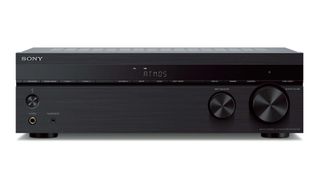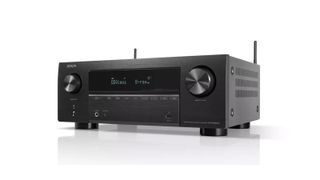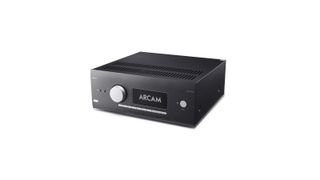

Max Freeman-Mills
The best AV receivers will completely transform your viewing experience. You can literally turn your home TV into a full on cinematic experience without having to shell out a lot of dough. Just add popcorn!
So what actually is an AV receiver I hear you ask? Good question. Essentially it is a device that looks after all your audio and video in one handy place and makes everything work as it should, like a conductor in an orchestra.
When it comes to audio, most AV receivers deliver two-channel audio, but if you want the best of the best, then you’ll want one that can deliver surround sound for that truly cinematic experience.
Things to consider when buying an AV receiver include what you want it to do, what outputs you require (such as HDMI), what audio formats you need support for, budget and more. And if you’re not entirely sure what you’re looking for, then that’s where we come in. We'll break down all the jargon and key information to figure out the best AV receiver for your needs.
And finally, if you’re looking to upgrade your entire home entertainment system, then we can help you with that too. We recommend checking out our guide to the best TVs for the perfect pixels, and the best soundbars for the best audio to go with it!
The best AV receivers in 2025
The best AV receiver for most people


1. Denon AVC-X3800H
Specifications
Reasons to buy
Reasons to avoid
The Denon AVC-X3800H sits squarely in the middle of the manufacturer’s range, and it’s perfectly balanced – offering all the features you’ll need at a price that won’t break the bank. This accomplished receiver not only decodes the main object-based audio formats like Dolby Atmos, it also includes enough powerful amplification to create a dynamic sense of immersion.
While the X3800H is capable of processing up to 11 channels, nine should be more than enough for most people, with a choice of 5.4.4 to 7.4.4 speaker configurations. You can even add dual subs, and the easy-to-use Audyssey room correction ensures the detailed and engaging delivery is combined into a cohesive and tonally balanced system with seamless steering of effects.
The X3800H is well-made, looks smart, and boasts extensive connectivity, while HEOS adds multi-room and even the option of wireless rears and sub. It not only works with Alexa and Google Assistant, but also Siri thanks to the inclusion of AirPlay 2. Here's our full five-star Denon AVC-X3700H review.


The best budget AV receiver
2. Sony STR-DH790
Specifications
Reasons to buy
Reasons to avoid
The Sony STR-DH790 is hard to beat when it comes to delivering home cinema on a budget. The build quality could be better, and it’s limited to seven channels of amplification and processing, but this receiver includes everything you need to start building a surround sound system.
It’s a piece of cake to setup, and while Sony’s room correction is fairly basic, the results are impressive for the price point. The built-in amps are surprisingly punchy, the delivery energetic, and effects are steered with precision, resulting in immersive Atmos and DTS:X action.
There are six HDMI inputs with 4K/60Hz and Dolby Vision passthrough, but there’s no HDMI 2.1 support. However, thanks to eARC this limitation can be bypassed, and while there’s no Wi-F either, music fans can still enjoy lossless high-resolution audio support and even DSD decoding.
The best mid-range AV receiver


3. Denon AVR-X2800H
Specifications
Reasons to buy
Reasons to avoid
The Denon AVR-X2800H could easily have been the best budget AV receiver, were it not for the Sony’s ludicrously cheap asking price. But since it sports many of the features found on the X3800H and retains a similarly poised performance, it certainly ranks as the best affordable AVR.
All the main audio formats are covered, and while the X2800H is limited to seven channels, it enjoys a serious amount of grunt that ensures a spacious and controlled delivery. The placement of effects is also precise, and Audyssey brings everything together in a balanced soundstage.
The X2700H was held back by just one HDMI 2.1 port, but its successor boasts a healthy three. It may not look particularly beautiful but that minor complaint aside, this is a feature-packed receiver for the money with HEOS multi-room, hi-res audio support, AirPlay 2 and the ability to work with Alexa and Google Assistant.
The best AV receiver for gaming


4. Yamaha RX-V6A
Specifications
Reasons to buy
Reasons to avoid
The Yamaha RX-V6A is another value contender that would also be in the running for budget AV receiver, were it not for the Sony. However this particular model has the edge when it comes to next-gen gaming with its three HDMI 2.1 inputs. Some of these features have yet to be added via firmware updates, but eventually the V6A will support 4K/120Hz, VRR and ALLM.
It will also support all the HDR formats like HDR10+ and Dolby Vision, plus just about any lossless high-resolution audio format you throw in its direction. Wi-Fi, Bluetooth and AirPlay 2 are all present and correct, plus there’s even a FM/AM and DAB+ tuner. You also get Yamaha’s superb MusicCast multi-room system, with the added bonus of support for wireless rears and sub.
While the built-in grunt is slightly lacking in the power department, Yamaha’s years of experience deliver a wonderful musicality. The Atmos and DTS:X performance is equally impressive, and while the processing is limited to seven channels, this receiver reveals a pleasing agility that responds to even the most dynamic soundtracks, resulting in an exciting overall performance.
The best ultra-premium AV receiver


5. Arcam AVR31
Specifications
Reasons to buy
Reasons to avoid
The Arcam AVR31 is the AV receiver of choice for the well-heeled home cinema fan, with a full selection of object-based audio formats that includes Atmos, DTS:X, IMAX Enhanced, and even the esoteric Auro-3D. Perhaps more importantly, it delivers these formats with processing up to a staggeringly immersive 15.2 channels, which means you can run a full 9.2.6-channel system.
The AVR30 only has seven amplification channels built-in (meaning it can drive seven actual speakers, even though it can understand many more channels), so you’ll need to add more amplification channels for greater immersion, but they are a magnificent seven. Using class Class G, resulting in a delivery that’s incredibly powerful and responsive, with plenty of headroom. The resulting sound field is precise, expansive and controlled, while dual sub support and class-leading Dirac Live room correction are the icing on the cake.
The AVR31 is also extremely well-made, with a full-colour LCD display on the front, and lossless high-resolution audio support to go with this receivers musical delivery. There are plenty of HDMI inputs that support HDR10+ and Dolby Vision passthrough, plus there’s eARC. The AVR 30 was also a top-tier choice (read our full Arcam AVR30 review.) but lacked the HDMI 2.1 support that is great for gamers and 4K 60Hz movies, the AVR31 has no such problem.
How to buy the best AV receiver for you
The obvious starting point is the number of built-in channels of amplification. If all you want is a basic surround system, then five channels (plus a subwoofer) will suffice. However you may as well go for seven channels, because then you can always add two more channels at the back or above using overhead or upward-firing speakers. If you’re planning to install more channels from the start, there are 9-, 11-, and even 13-channel AV receivers available.
You also need to consider how many channels the AV receiver can discreetly process. A basic seven-channel model should deliver 5.1, 7.1, or 5.1.2 speaker configurations - with the latter representing five ear-level channels, a subwoofer, and two overhead channels. However, there’s no harm in buying an AVR that can process more channels than it has built-in, because if you catch the immersive audio bug you can always add an extra power amplifier later.
Speaking of immersive audio, the ability to decode Dolby Atmos is crucial because it’s the dominant object-based format. DTS:X is nice to have, but unless you have a large Blu-ray disc collection it’s largely redundant. The same is true of IMAX Enhanced, and as for Auro-3D, there’s virtually no content, so you really don’t have to worry about that format.
An AVR may have a host of connections at the rear, but these days HDMI is what’s important. The more HDMI inputs the better, because you’ll be surprised how sources add up. An HDMI output that supports eARC is also useful, while another output for a second zone is always handy. It’s important that the HDMI ports can pass 4K/60Hz and HDR10, and ideally HLG, HDR10+ and Dolby Vision as well. If you’re a next-gen gamer you’ll also want the receiver to support 4K/120Hz, VRR and ALLM. As things stand, 8K support is less important due to a lack of native content.
Watching movies in near-cinema quality is probably your main incentive for buying an AV receiver, but there’s no reason it can’t also be used for listening to music. Multi-channel music remains popular, and a number of music streaming services now support Dolby Atmos, so if an AVR also supports lossless high-resolution audio, it can act as an effective Hi-Fi and surround sound entertainment hub.
A number of manufacturers also offer multi-room functionality, either through proprietary systems like Denon’s HEOS and Yamaha’s MusicCast, or via third-party solutions like Chromecast. Some of these systems even provide the capability to add wireless rear speakers and a wireless subwoofer, which makes things tidier. Other useful features include remote apps, smart assistants, Wi-Fi, Bluetooth, and AirPlay for Apple users.
The biggest impact on the sound quality of a system is the room itself. You can spend a fortune on speakers but they’ll still sound like a bag of spanners if the room is problematic. This issue is compounded when you start adding more and more speakers, and it’s where room correction comes in. It’s important that an AV receiver includes an effective and easy to use system. Some will also include the option of running dual subwoofers, which not only produces a more balanced low-end, but also allows you to fully appreciate bass-heavy Hollywood blockbusters.
Finally, a receiver is technically an integrated amplifier with a built-in radio tuner. Ironically, the profusion of internet radio stations has resulted in some manufacturers dropping traditional FM/AM and DAB+ tuners from their newer models, but the name AV receiver continues to be used.
Sign up to the T3 newsletter for smarter living straight to your inbox
Get all the latest news, reviews, deals and buying guides on gorgeous tech, home and active products from the T3 experts
Steve Withers is a professional calibrator and freelance journalist who regularly contributes to T3, reviewing audio and video products, and writing articles. Steve has been writing about audio and video products for over ten years and, along with T3, he also contributes to TechRadar, Trusted Reviews, Expert Reviews, AVForums, Pocket-lint, Home Cinema Choice, and Wired. Steve is Level 2 certified with THX, the Imaging Science Foundation (ISF) and the Home Acoustics Alliance (HAA). As such, he remains abreast of all AV technology developments and the latest industry standards as we transition into a new era in home video and audio.
- Max Freeman-MillsStaff Writer, Tech
-
 Amazon Fire TV Omni Mini-LED 4K TV review: a huge step up in performance
Amazon Fire TV Omni Mini-LED 4K TV review: a huge step up in performanceAmazon's second-gen Fire TV and first Mini-LED TV is a great option
By Steve May Published
-
 Early Black Friday deal sees price of massive 75-inch TV slashed
Early Black Friday deal sees price of massive 75-inch TV slashedYou'll even get a free copy of NBA 2k25
By Sam Cross Published
-
 Your Samsung TV just got its biggest free upgrade yet
Your Samsung TV just got its biggest free upgrade yetOne UI is rolling out to the latest Samsung TVs now
By Britta O'Boyle Published
-
 Best earbuds 2025
Best earbuds 2025Small in size but big in sound quality – these are ideal in-ear options
By David Nield Last updated
-
 Best PS5 SSD 2025: store 100s more games on your PlayStation 5
Best PS5 SSD 2025: store 100s more games on your PlayStation 5The definitive guide to the best SSDs for PS5 available today
By Rik Henderson Last updated
-
 Best Sony TVs 2024: from Bravia 9 Mini LED to Bravia 8 OLED and beyond
Best Sony TVs 2024: from Bravia 9 Mini LED to Bravia 8 OLED and beyondExplaining Sony's range of 2024 TVs, including new naming strategy and range of technologies
By Chris Hall Published
-
 This ultra-bright mini-LED TV is the display of my dreams
This ultra-bright mini-LED TV is the display of my dreamsTCL's next flagship looks fantastic
By Andy Sansom Published
-
 Best soundbar for small TVs 2025: clearer, deeper TV sound in any space
Best soundbar for small TVs 2025: clearer, deeper TV sound in any spaceThe best soundbars for small TVs 2025} can bring you big sound from a compact unit
By Simon Lucas Last updated


